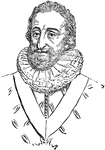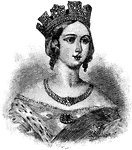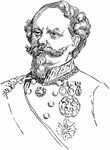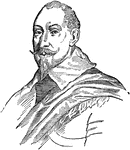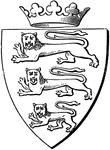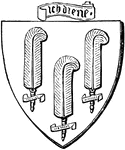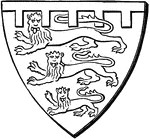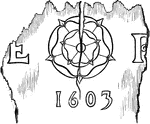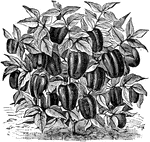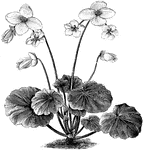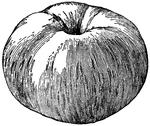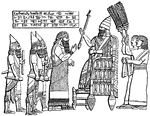
Proclamation
"Proclamation of King William as Emperor of Germany at Versailles, January, 1871."—Myers, 1905

Napoleon Returning to France
"Not made on the spot but probably presenting approximately the king of equipage in which Napoleon traveled.…

The Moabite Stone
"Found in 1868 at Dîbân, east of the Dead Sea. The monument records the victory of Mesha,…

The Great Pyramid of Giza
"The pyramid when completed had a height of 481 feet. It is now 451 feet high. Its base covers 13 acres.…

The Cylinder of Sennacherib
"A six-sided cylinder of terra-cotta found at Ninevah. It contains a record of eight years of Sennacherib's…

Tomb of Cyrus the Great
"The mausoleum is built of immense marble blocks, joined together without cement. Its total height,…
An Assyrian Statue
"The king, a rude heroic figure, stands upright before the god. He holds a club in the left hand, in…

Charlemagne
The King of the Franks from 768 and the Emperor of the Romans from 800 until his death in 814.
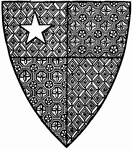
Shield of Robert de Vere
The heraldic shield of Robert de Vere, close advisor of King Richard II of England.
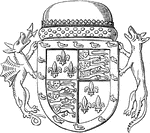
Shield of Jaspar Tudor
"Shield and supporters of Jaspar Tudor, K.G., Earl of Pembroke in 1452 and in 1485 Duke of Bedford;…
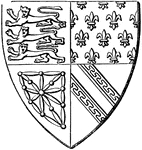
Shield of Queen Isabella
"Quartered shield of arms borne by Isabella, Queen of Edward II."—Aveling, 1891
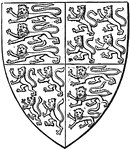
Shield of Queen Philippa
The heraldic shield of Philippa of Hainault, the Queen consort of Edward III of England.

Insignia of the Order of the Star of India
"This Order was instituted by Her Majesty the Queen, in the year 1861, for bestowing honor upon the…
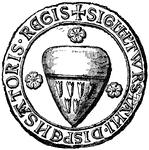
Seal of Thurstan
The heraldic seal of the archbishop of York, who worked under kings William II of England and Henry…
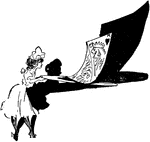
Young Woman and King of Hearts
A cartoon of a young woman carrying a tray, which holds an oversized playing card of a King of Hearts.

Flowers of Fuchsia Gipsy Queen
Fuchsia gipsy queen flowers have scarlet sepals and a violet corolla.
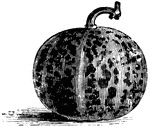
Queen Anne's Pocket Melon
Queen Anne's Pocket Melon is also known as the Dudaim Melon. This melon is very small and round. The…
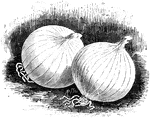
Queen Onions
The queen onion is a small and very early variety of the silver-skinned section. The bulbs are very…
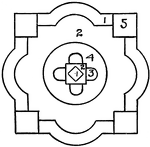
French Pattern Bedding
The number represent different plants in this French pattern bedding. (1) sulphur queen, (2) blue perfection,…
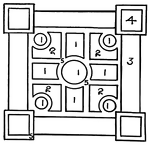
Italian Pattern Bedding
Pictured is an Italian pattern of bedding, the numbers representing different plants. (1) orange king,…
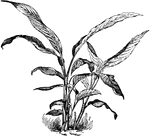
Curcuma Petiolata
The common name of curcuma petiolata is queen lily. The leaves are six to eight inches long. The flowers…

Curcuma Petiolata
Illustrated is the queen lily, curcuma petiolata, in flower. The flowers are pale yellow. The flowers…
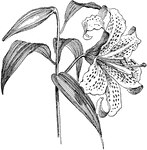
Golden-Banded Lily
Lilium auratum has several common names including golden-banded lily, golden-rayed lily, and queen of…

KIng Suction Machine
The King Suction Machine was considered one of the most effective locust extermination machines of its…

Lantern Tower at Grey Friars, King's lynn
In Gothic architecture, a lantern tower is frequently placed over the center of cross churches, and…
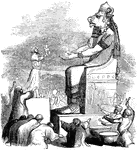
Moloch Being Worshipped
Moloch (or Mo'lech) is the name of an ancient deity which was worshipped by the Ammonites. The Israelites…

Row 3 of Hieroglyphics
A row of hieroglyphics showing men working. These are to honor Shalmaneser, king of Assyria.

Medal of Parthia
A medal of Parthia, with a portrait of one of its kings. On the reverse are instruments of worship,…

Parthia
The head engraved on one side of the coin is thought to be the portraits of the king of Parthia. In…
